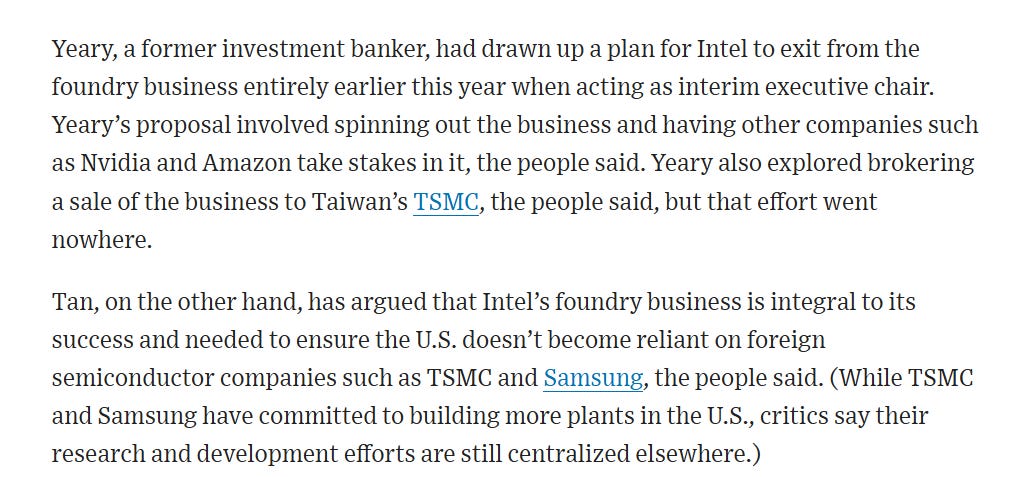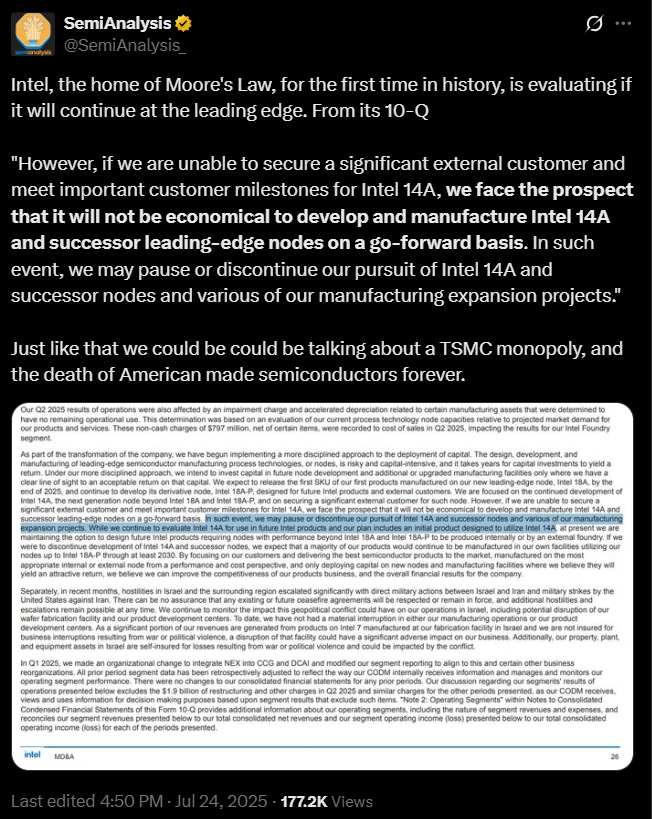Intel's One True Stakeholder is Here
What an Intel with Government help would look like.
Finally, after all this time, I think the endgame for Intel might be here.
If you missed the news, there is a rumor that the Trump administration could be taking a stake in Intel. This feels like a long time coming, but the incompetent board is still fighting. For more work on the board, read both mine and SemiAnalysis’s pieces.
The final stakeholder is here, and Intel needs to do a better job of capturing its attention and help. Let’s walk through a brief recap of how we got here and where Intel could go from here.
Intel is a Walking Death
Intel was once the greatest semiconductor that ever was. And I cannot express how true this was. Nvidia is the shining star today, but it didn’t invent as many foundational technologies as Intel did. Intel’s story is THE story of Semiconductors. From the Traitorous Eight leaving Shockley’s lab, to Bob Noyce leaving Fairchild to then found Intel, the history of Semiconductors IS the history of Intel. Intel invented the concept of the Microprocessor, a CPU itself, and made the world’s first commercial RAM, among other innovations such as strained silicon, high-k metal, and FinFETs.
And it’s no surprise that the future of American semiconductors has Intel written all over it. But there’s no other way than forward, and I think it’s time to consider what needs to happen realistically, and that’s the death of the Intel we once knew to make room for what’s next. The key is that while CPUs don’t matter, the only American leading-edge foundry left making them is critical.
The problem is that the company that funds it might run out of money, and that’s why they need to publicly threaten to stop financing the future of the foundry, because it’s a problem they can’t do alone. That is why I believe they so publicly announced the ending of future nodes past 14A. If you want us to continue, we need help.
It’s time to threaten the future of America to the one stakeholder that matters: The Government.
Intel’s Foundry Must Live, at Any Cost
The calculus for America is pretty simple. In my view, there is very little strategic importance to the Intel CPU business. The x86 ecosystem was once the most incredible compute ecosystem, but AMD designs better chips than Intel could; Intel has the one thing that AMD does not, a Fab. The fabless business at Intel has a real issue in that making a CPU is becoming a relatively commoditized business. ARM has made it possible for almost any hyperscaler to have its ARM-based CPU, while AMD continues to outdesign Intel at its core job, and that’s not even discussing the longer-term RISC-V ecosystem.
Adding up the CPU side, I see a business with massive competition and Intel not at the top of the stack. Intel has to deal with increasing competition in’s core profit center while at the same time covering the increasingly heavy burden of a leading-edge fab. There is only one leading-edge foundry (TSMC), and a second American option is the single highest value-added project of all time.
If the DOD can become the largest shareholder in MP, a potential hedge for rare earth minerals, the government should take a stake in Intel. Unlike rare earth, which is an exercise of moving cost curves down in a very heavy-duty industry, this is technology that requires real IP and not moving more earth out of the ground. A compelling framing is replacement cost, and the US would have to pay like 200 billion or more to “replace” the Intel we have today. Throwing money to sustain it makes sense for the US.
What Would Intel’s Foundry Look Like as a Standalone
Here’s the core take. We cannot rely on Taiwan for the future of semiconductors. The more capacity we get from TSMC, the more we remain reliant on R&D in Taiwan rather than the US. Intel must be standalone and must have the capabilities to do the two things the US critically needs. High-end logic and military capabilities. I’d argue the second is met chiefly, but the first Intel is hopelessly behind.
What’s worse is that Intel has a bad customer, itself. Intel needs a good customer to be the anchor, and sadly, the core customer is a CPU company that is struggling to find its way in an accelerated compute world. So the core problem is that the funder of the large domestic capacity is a horrible customer, and the bill itself is extremely steep to pay. A stake by the government doesn’t sound like such a bad thing if it is a public asset. The problem once again is incentives, and how the hell does that even fix Foundry, anyway?
Trump’s Superpower: Bullying Partnerships
The solution almost seems obvious. Intel Foundry has many critical issues with competitive products, technology that customers want to use, and a customer experience that makes it possible. Nvidia, Apple, Broadcom, AMD, and Qualcomm, the Fabless 5 of America, all struggle with this chicken-and-egg problem. Will they be around?
I think that LBT knows it’s critical, Trump knows it’s critical, and Trump does have quite a superpower. If it means you do not pay tariffs, why not throw your orders towards a large, partially government-owned entity called IFS? If there is a huge stake, this could be considered compliant with investing in America, and the top 5 have hundreds of billions of dollars of orders. Seriously considering the process in exchange for paying less tariffs is a straightforward deal, and one that Trump is amazing at making.
What’s more, the rumors of a hyperscaler investment to me seem like another “investment in America” opportunity. That’s been the clear pattern: commit to invest more in America, and we will let you keep overseas revenue streams. Trump should and could do it - and Intel could have a path out for now.
It’s time to invest in the American (gold-plated) foundry of the future. I believe that large foundry partnerships will be announced as part of ongoing investments in America. In theory, Foundry needs orders to exist, and this is how they will get them.
Trump can bully Broadcom, Nvidia, Qualcomm, Apple, and AMD to put orders towards Intel, while possibly forcing Amazon, Microsoft, Google, and others to make a large investment in the fab itself (or push orders). Additionally, forcing semicap companies like KLAC, Applied Materials, and Lam Research to invest and give resources in exchange for approved licenses is another example of a carrot and a stick. I think Trump could forge the giant partnership to happen, but then execution is all up to Intel. And LBT is still once again qualified for the job.
Now, how does that impact the equity? Yeah, we will see about that.



